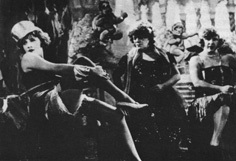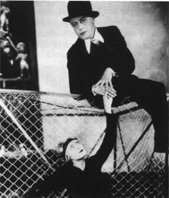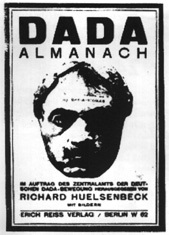The German Cabaret
The cabaret of 1920's Berlin has become familiar to many through the hit musical Cabaret, Bob Fosse's highly atmospheric film, images of smoke-filled clubs, semi-naked women, and Marlene Dietrich as femme fatale Lola Lola in The Blue Angel. However, by the late 1920's the German cabaret, or Kabarett, was already nearing the end of its heyday, as political satire was played down in favour of outrageous dance routines and sentimental ballads.
The roots of German cabaret lie not in 1920's 'Berlin, but in pre-war Munich. Although some experimentation with a cabaret style imported from Paris took place in Berlin at the turn of the century - notably at the Schall und Rauch cabaret of theatrical impresario Max Reinhardt - it was in the south of Germany that das Kabarett sprung to life as a new and vital form of entertainment.
BEGINNINGS IN MUNICH

Marlene Dietrich in The Blue Angel |
Munich was Germany's artistic centre at the turn of the century. The degree of intimacy was greater here than in Berlin and facilitated the formation of and communication between small groups of artists with a common interest and purpose. The Art Nouveau magazine judged flourished, as did the satirical weekly Simplicissmus. And in the Schwabing district performers, writers, artists and musicians congregated at the many cafes, united in their antipathy to the rigid nature of the state and the moral hypocrisy and smug self-satisfaction of Munich's bourgeoisie.
This strong impulse of modernism, coupled with a considerable following for a spirited variety or music hall, meant that Munich was very receptive to the new and invigorating form of entertainment: the cabaret.
|
The Executioner's Song
|
As a regular guest of the Elf Scharfrichter, Wedekind wrote and performed his famous Moritaten, satirical ballads, replete with horrific detail and moralising judgements, which Brecht would later exploit so effectively and which established a format for the German Cabaret song style.
Schwabing was also home for another early German cabaret - Simplicissimus, named after the satirical magazine presided over by Kathi Kobus. Here Isadora Duncan is said to have danced naked on the tables until the early hours. However, the prevailing spirit belonged to Ringelnatz, whose poems displayed a lyrical playfulness, while maintaining atone sharply critical of Germany's arrogant nationalism. Erich Müsam was also a regular performer at Simplicissmus. His acidic poems and songs condemned his contemporary society and infringements of liberty by both Left and Right.
THE AVANT GARDE
Until the aftermath of the First World War had passed, cabaret was very much a forum for experimentation by the cultural avant garde. The Neopathische Cabaret in Berlin became a stage for the early expressionists. Leading Berlin actress Tilla Durieux recited Wedekind, shadow plays were performed and there was music by Schönberg and Debussy. Expressionist poets also found an audience for their work here. Meanwhile Dada was born in Zurich at the Cabaret Voltaire where Hugo Ball, in cubist costume, recited the first abstract phonetic poem 'gadji beri bimba'. The dadists' motto was "Kunst ist Scheisse" (art is shit). They rejected conventional art forms and created an irrational, nonsensical means of expression. This was their way of trying to make sense of an apparently senseless world. When Dada reached Berlin during the violent uprisings, strikes and clashes of the last year of the war, it had become more politicised, though the instinct to shock and provoke audiences remained. The Berlin dadaists, among them George Groszand inventor of photomontage John Heartfield, took their cabaret onto the streets, shouting slogans, putting up stickers, marching and playing band music. The first International Dada Fair took place beneath a large stuffed effigy of a German Officer with a pig's head.
HOT DOGS AND COLD BEER
 A scene from the first production of Brecht's The Threepenny Opera at the Theater am Schiffbauerdamm, 31 August, 1928. (BPK/Willy Säger) |
With the end of the Wilhelminian Empire and the proclamation of the Weimar Republic came the end of censorship. In reaction against the old regime Berlin revelled in its new found permissiveness and became Germany's cosmopolitan capital. In this hedonistic atmosphere cabarets mushroomed everywhere. At the Wintergarden audiences ate hot dogs and drank cold beer while being entertained by a master of ceremonies dressed in black and silver, 'maharajahs' lying on beds of nails and a variety of revue sketches. Anita Berber danced nude on the stage of the White House and used cocaine and morphine, was married and divorced tried lesbian love and could be seen at every night club, boxing match, bicycle race, bar and party."
Eldorado was a well-known transvestite bar that flourished in Berlin in the 1920s. It was frequented not only by transvestites and homosexuals but by artists, writers and the beau monde of the day. It became fashionable to enjoy the voyeuristic thrill of mingling with society's outsiders, as Peter Sachse wrote in the Berliner journal in 1927. "The latest rage of Berlin "Society" is to spend an evening in the Eldorado. Over there sits a well-known director of a major bank, just there is a gentleman from the Reichstag and a lot of theatre and film people ... Those who are here for the first time and are curious play a game, trying to guess who out of the "special" clientele is really a "lady" and who is really a "man". They don't always

|
Though much of their art had roots in Expressionism, the post-war Dadaists reacted violently against the pathos and self importance of the older school. The irreverently touched up mask of Beethoven on the cover of Richard Huelsenbeck's Dada Almanach' sums up the iconoclastic spirit of the new movement. |
guess right. The techniques of dressing up; doing one's hair and make-up have achieved undreamt of perfection.'
TUCHOLSKY AND BRECHT
Kurt Tucholsky wrote chansons which were sung all over Berlin, and which warned of the dangers lurking beneath the surface of frenzied gaiety. Walther Mehring created brilliant cabaret songs incorporating jazz, the brutal wit of street talk and the earthy Berlin dialect. Erich Kastner coined the term "Gebrauchslyrk' for his own brand of cabaret verse: satirical witty and compassionate. The young Bertolt Brecht was drawn to cabaret, which he had experienced during its early days in Munich, as an exciting means of expression which was dynamic and popular and had none of the elitism which marked the established theatre. He worked closely with Munich's answer to Charlie Chaplin, Kari Valentin, whose estranged thinking processes and talent for drawing extraordinary consequences from ordinary events made a great impact on Brecht. Brecht wrote a number of songs or Moritäten, for both the cabaret and for his own theatrical work. His collaboration with Kurt Weill produced some of the most memorable songs of the period, including Mack the Knife, Pirate Jenny, The Alabama Song and Surabaya Johnny. Indeed much of what constitutes 'Brechtian Theatre' derives from the cabaret format.
INTO THE DEPRESSION
As Germany entered a new decade, Berlin was marked by economic depression and a polarisation of politics to the left and Right. In the cabaret,

Eldorado by Otto Dix |
many of the acts softened their social and political comment and it was left to the Master of Ceremonies, or conferencier, to meet any challenges from the audience and to inject the proceedings with the satirical edge that had become the cabaret's essence. Conferenciers had to be well-versed in literature, masters of improvisation, possess an acid wit and be fully in tune with the street politics. During the period of inflation, Fritz Grunbaum, conferencier at the Kabarett der Komiker, or Kade Ko, as it was known, held the main core of his audience - nouveaux riches and philistines - in such contempt that he was compelled to hurl insults at them on a nightly basis. On one occasion he remarked to a group at the front "My dear ladies and gentlemen, there in the front. It is bad enough that I have to see you eat in such a time, but also to have to hear you eat ...!' Paul Nikolaus had a slightly different style as conferencier, and would give a critical expose of the next day's news before the audience would read it in the morning's papers.
Another cabaret which persisted with its assault on right-wing politics and the prevailing anti-Semitism was Die Katacombe, in which Werner Finck kept up a perpetual barrage of insults at the expense of the 'brownshirts', now seen everywhere in Berlin. To a Nazi who shouted 'Dirty Jews' he replied, 'I'm afraid you're mistaken. I only look this intelligent'. Eventually Finck needled the Nazis beyond endurance and die Katacombe was closed down in 1935.
When Hitler took power in 1933, cabaret was one of the first victims of Nazi terror. Some writers and performers were arrested and taken to concentration camps; some committed suicide; and others left Germany for America or other parts of Europe. The few who tried to return to cabaret after the war found that it had lost the zest, the vitality and bite that had made it such a remarkable force during the early part of the century.

